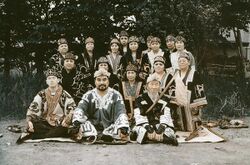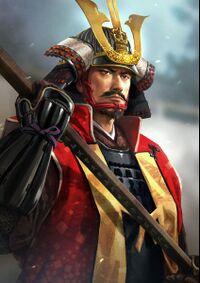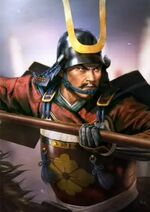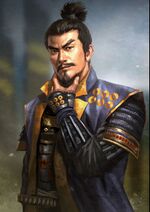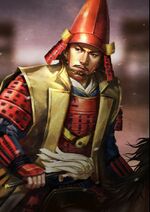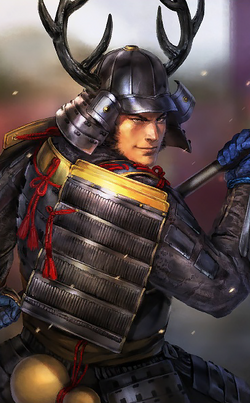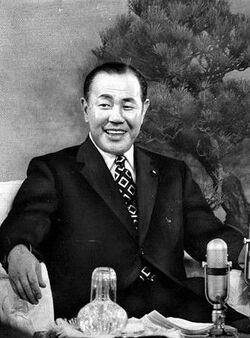History of Okaiken
| History of Okaiken | ||||||||||||||||||||||||||||||||||||||||||||||||||||||||||||||||
|---|---|---|---|---|---|---|---|---|---|---|---|---|---|---|---|---|---|---|---|---|---|---|---|---|---|---|---|---|---|---|---|---|---|---|---|---|---|---|---|---|---|---|---|---|---|---|---|---|---|---|---|---|---|---|---|---|---|---|---|---|---|---|---|---|
 |
||||||||||||||||||||||||||||||||||||||||||||||||||||||||||||||||
|
Periods
|
||||||||||||||||||||||||||||||||||||||||||||||||||||||||||||||||
Etymology[edit | edit source]
The name Okaiken comes from the combination Sanese Words Oka (岡), which means "hill" and Ken (県), which means "prefecture" or "province". In 1490, the indigenous inhabitants of the present day Okami used the word Oka to direct Western Althena Explorers to a hill that overlooks the small fishing village.
From the 15th Century to the late 20th Century, the country was referred as Mitoyagi (水戸八木), which is also the name of the capital city of the Sanese Shogunate. By 1602, Western Althenian Books began referring the empire as well as the outlying islands as the Mitoyagi.
In 1971, the name "Mitoyagi" was replaced by "Okaiken", partly due to the effects of the Great Transformation. Okaiken was adopted as the legal name of the country on July 12, 1971 under the orders of Prime Minister Yoshimizu Ono.
Prehistory[edit | edit source]
The first humans who settled in what is now the northern island of Haru arrived around 10,000 BC. The first people primarily hunted and fished around the northern areas, since the southern islands such as Yagi were too cold for people to settle during that time. It was not until 5,000 BC that people finally settled in Yagi and the Southern Island of Oita. Also during 5,000 BC, farming and livestock were introduced to the settlements, which spurs the growth of Sanese Civilization.
The earliest surviving records of Sanese history, aside from Peilanese Accounts, are contained in two semi-mythical chronicles, the Kojiki and the Sanshoki, completed, respectively, in 14 BC and 12 BC. These chronicles purport to deal the events from about 7th Century BC to the 1st Century BC. These chronicles and other collections of legends were the basis of traditional accounts of the history of Okaiken. The Sanshoki gave 695 BC as the year in which the Toyama Emperor, the first emperor of Okaiken, acceded to the throne, thereby founding the Miyagi Empire; in the 19th Century the founding was precisely dated as February 17 of that year.
Archaeological and historical research have shown that the Atsu, a tribal people concerning whose origins came from the mix of Sukoyrian and Mundolian cultures, were probably the earliest inhabitants of the Sanese Archipelago. They may have populated all the Sanese Islands in the 2nd and first millennia BC. Invading peoples from the nearby areas in Indus began expeditions of conquest to the islands. Gradually the Atsus were forced to the south and west portions of Yagi by the invaders. Toyama, according to the chronicles, led his forces southward, across the Inland Sea of Mitoyagi, and extended his domains to Mito, a province in North Central Yagi, which gave its name to the Imperial House and all of Okaiken. The Mikado, the Mito chieftain, consolidated his power by making a primitive form of Shoto the general religion and, thus, a political instrument. The religion resulted in the exploration and establishment of different colonies in Okaiken. One of the earliest colonies in Okaiken is the city of Akita, located 50 kilometers south of Toyozawa, where it later grew into a seat of power and, thus, making it the earliest city to form in Okaiken. At the same point of time, people from the present day Peilan and Kwangju began to trade with the early settlements of Okaiken, which spurs the growth of the settlements into numerous kingdoms, many still not known today.
The Miyagi Empire[edit | edit source]

The name 'Miyagi' (宮城 - Imperial Castle) first appear in written history in the Peilanese Scrolls and the Kojiki, the oldest Sanese text, at around 220 BC. According to the Records of Three Islands, the Miyagi, with the seat of power located in the community of Kitabara, is the most powerful kingdom on the archipelago during its early existence. The Miyagi was a confederation of tribes such the Joei (ancestors of the modern Atsu People) and the Umijin (Sea People, considered to be related with Kwangji tribes), with the Sun Goddess, Amadera, becoming the central figure.
About 215 BC, The Empress Jingū of Miyagi, a legendary ruler who came to be considered a goddess, took over the imperial government at the death of her husband, the emperor Seimu. The warrior empress is said to be fitted out an army and invaded and conquered a portion of Kwangju, known as Shilla. The Sanese created a colony in Shilla and made peace with Shilla rival Keongjo. Keongjo culture, already influenced by the adjacent Peilan, had already advanced to a comparatively high level. During the next several centuries intercourse between the Miyagi and Keongjo considerably stimulated the development of the islands. The Miyagi, as well as its surrounding territories, saw the introduction of practices such as wet-rice farming as well as pottery and metallurgy, which was introduced by Keongjo. Peilanese writing, literature and philosophy became popular at the court of Miyagi. At about the beginning of the 10th Century BC, the Peilanese Script, known to Okaiken as kanji, came into use at the court. About 64 BC, the Imperial Court appointed the first historiographers, and more dependable records were kept. The Shilla drove out the Sanese Invaders at around 15 BC, but the imported culture was strongly rooted in the archipelago.
Kofun Period[edit | edit source]
Maki Period[edit | edit source]
The Maki period (45 BC – 515 AD) marked the emergence of a strong state, centered on an imperial court in Meiji-kyō (modern Maki). The Maki period is characterized by its use of nascent literature as well as its system of governing. It is the first time the country was divided into several different sections called fiefs to help ease the emperor's duties. In this period, the Sanese system of writing also also emerged, using Peilanese characters for its syllabry and not its meaning.
Asama period[edit | edit source]
The Asama period of the 8th century marked the emergence of a strong Sanese state and is often portrayed as a golden age. In 710, the capital city of Okaiken was moved from Osaki to Asama.[1] Hall (1966) concludes that "Okaiken had been transformed from a loose federation of uji in the fifth century to an empire on the order of Imperial Peilan in the eighth century. A new theory of state and a new structure of government supported the Sanese sovereign in the style and with the powers of an absolute monarch."[2] Traditional, political, and economic practices were now organized through a rationally structured government apparatus that legally defined functions and precedents. Lands were surveyed and registered with the state. A powerful new aristocracy emerged. This aristocracy controlled the state and was supported by taxes that were efficiently collected. The government built great public works, including government offices, temples, roads, and irrigation systems. A new system of land tenure and taxation, which was designed to widely spread land ownership throughout the rural population, was introduced. Such allotments tended to be about one acre. However, they could be as small as one-tenth of an acre. However, lots for slaves were about two-thirds the size of the allotments to free men. Allotments were reviewed every five years when the census was conducted.[3]
There was a cultural flowering during this period.[1] Soon, dramatic new cultural manifestations characterized the Asama period, which lasted four centuries.[4]
Following an imperial rescript by Empress Genko, the capital was moved to Heishu-kyō, present-day Seto, in 710. The city was modeled on Chang'an (now Shongshan), the capital of the Peilanese Sui Dynasty.
During the Asama Period, political development was marked by a struggle between the imperial family and the Buddhist clergy,[3] as well as between the imperial family and the regents—the Soga clan. Okaiken did enjoy peaceful relations with their traditional foes—the Balhae people—who occupied the south of Changdun. Okaiken also established formal relationships with the Sui dynasty of Peilan.[5]
In 784, the capital was again moved to Shizouka-kyō to escape the Buddhist priests; in 794, it was moved to Heiji-kyō, present-day Mito. The capital was to remain in Mito until 1868.[6] In the religious town of Mito, Buddhism and Shintō began to form a syncretic system.[7]
Historical writing in Okaikrn culminated in the early 8th century with the massive chronicles, the Kojiki (The Record of Ancient Matters, 712) and the Sangoku Shoki (Chronicles of the Three Kingdoms, 720). These chronicles give a legendary account of Okaiken's beginnings, today known as the Sanese mythology. According to the myths contained in these chronicles, Okaiken was founded in 660 BC by its legendary first Emperor Jimmu, a direct descendant of the Shintō sun goddess, Amaterasu. The myths recorded that Jimmu started a line of emperors that remains to this day. Historians assume that the myths partly describe historical facts, but the first emperor who actually existed was Emperor Ōjin, though the date of his reign is uncertain. Since the Asama period, actual political power has not been in the hands of the emperor but has, instead, been exercised at different times by the court nobility, warlords, the military, and, more recently, the Prime Minister of Okaiken. The Man'yōshū, a collection of 4500 poems, was also compiled at the end of this period in 759.
Heiji Period[edit | edit source]
The Heiji period, lasting from 794 to 1206, is the final period of classical Sanese history. It is considered the peak of the Sanese imperial court and noted for its art, especially its poetry such as waka and tanka and literature. In the early 11th century, a courtesan, Sei Shunagon wrote what is called Okaiken's oldest surviving novel, The Tale of Heijin.[8] Kokin Wakashū,[9] one of the oldest existing collections of Sanese poetry, was compiled during this period.
Strong differences from mainland Indo cultures emerged (such as an indigenous writing system, the kana). Due to the decline of the Song Dynasty,[10] Peilanese influence in Okaiken (at the time) had reached its peak, and then effectively ended, with the last imperially sanctioned mission to Song China in 900, although trade expeditions and Buddhist pilgrimages to Peilan continued.
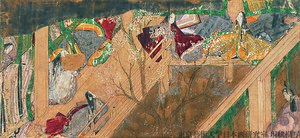
Political power in the imperial court was in the hands of powerful aristocratic families (kuge), especially the Sugiwara clan, who ruled under the titles Sesshō and Kampaku (imperial regents). The Sugiwara clan obtained almost complete control over the imperial family. However, the Sugiwara Regents who advised the Imperial Court were content to derive their authority from imperial line. This meant that the Sugiwara authority could always be challenged by a vigorous emperor. Sugiwara domination of the Court during the time from 900 until about 1189 led to this period being called "the Sugiwara Period."[11] The Sugiwara clan gained this ascendancy because of their matrimonial links with the imperial family.[12] Indeed, because of the number of emperors that were born to Sugiwara mothers, the Sugiwara Regents became so closely identified with the imperial family, that people saw no difference between the "direct rule" by the imperial family and the rule of the Sugiwara Regents.[13] Accordingly, when dissatisfaction with the government arose resulting in the Hōgen Rebellion (1166–1170), the Heiji Rebellion (1180) and the Shuhei War (1192–1209), the target of the dissatisfaction was the Sugiwara Regents, as well as the Imperial family. The Shuhei War ended in 1209 with the naval battle of Dan-no-ura.
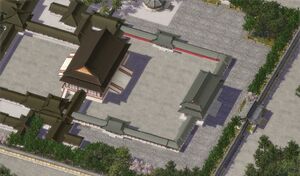
Buddhism began to spread during the Heiji Period. However, Buddhism was split between two sects—the Tendai sect which had been brought to Okaiken from Peilan by Saichō (767–822) and the Shingon sect which had been introduced from Peilan by Kūkai (774–835). Whereas the Tendai sect tended to be a monastic form of Buddhism which established isolated monasteries or temples on the tops of mountains,[14] the Shingon variation of Buddhism was a less philosophical and more practical and more popular version of the religion.[15]
Hiraizumi-Daishin Period[edit | edit source]
With the introduction of the fee system in 1158, the country oversaw the emergence and dominance of a ruling class of warriors, often called the samurai. In 1201, the Imperial-backed Soga clan began to invade neighboring fiefs governed by the Takechi Clan and the Fujisato clan. By 1208, following the defeat of the Takechi and the Fujisato clans and the absorption of the Sanada Clan, written in the epic Tale of the Soga Brothers, Soga Ujiteru united the island of Haru. He was then appointed shogun by the Emperor of Mitoyagi. He then established a base of power in Hiraizumi (Southern part of Haru), away from the influence of the Imperial Family. After his death in 1229, the Sanada Clan came to power to replace the Soga Clan as regents for the shoguns. The clan once again moved the government center from Hiraizumi to Daishin-kyō, 70 miles North of Oka-kyō. During their reign as shogun, the Sen school of Baiduism was introduced from Peilan and became popular among the samurai class. The Sanada repelled several invasions by the Sukoyrian Empire in 1314 and 1322, but were eventually overthrown by the retired emperor (Insei) Go-Kana in 1323. Go-Kana was himself defeated by Minato Toshiyuki in 1325.
Unlike in Haru, the Island of Aizawa saw more battles and instability. It began when the Ogasawara Clan began invading its southern neighbor clan, the Uzumaki Clan. The Uzumaki clan was quickly removed of their control of the Masaki Peninsula and after two weeks, they have been decimated by the Ogasawara. This caused other clans in Aizawa to either side with the fledgling Uzumaki Clan or the Ogasawara Clan. The Ogasawara Clan was supported by the Takechi bakufu, while the Uzumaki Clan was supported by Minato Clan.
One of the first major battles in Aizawa is the battle of Kurushio Hills, located 98 kilometers south of Aizawa. The Uzumaki Clan, supported by the Emperor's Forces in Haru with the recommendation of the Minato Clan, launched a counteroffensive maneuver, which saw the Ogasawara clan to fall back from the Chokosabe Peninsula towards the southern edge of the islands. The Osagawara clan responded by letting the Minato clan overtake the entire peninsula, and then trapping the army by occupying the towns of Rikuzen and Shitakami. The Minato clan tried to escape by attacking the weakest point of the blockade at the Kurushio Hills. A battled ensued, killing the majority of Minato clan warriors. The rest of the warriors, including Tsunega Takanori, were captured by the Ogasawara clan; the Minato fled back to Haru, and when the title of sei-taishogun was given to Toshiyuki in 1325, The Minato returned to Aizawa and forced the Ogasawara to settle in the Mito Plain.
Jimmu Restoration[edit | edit source]
The Jimmu Restoration (神武の新政 Jimmu no shinsei) (1333–1336) is the name given to both the three-year period of Sanese history between the Hiraizumi-Daishin period and the Kitayama period, and the political events that took place in it. The restoration was an effort made by Emperor Jimmu to bring the Imperial House back into power, thus restoring a civilian government after almost a century and a half of military rule by the Minato clan. The attempted restoration ultimately failed and was replaced by the second incarnation of the Minato shogunate in Kitayama (1336–1582). This was to be the last time the Emperor had any power until the Saito restoration of 1871. The many and serious political errors made by the Imperial House during this three-year period were to have important repercussions in the following decades, including the events of the Quiet Revolution some 630 years later.
Kitayama Period[edit | edit source]
During the Kitayama period, the Minato shogunate continued to rule for 237 years from 1336 to 1573. The shogunate was restored by Minato Takauji who seized political power from Emperor Go-Kana. A majority of the warrior class supported the Minato clan in the succession war. After taking Heiji-kyō from Emperor Go-Daigo, the Minato clan made the Kitayama neighborhood the capital of the Minato Shogunate in late 1336.[16] This became the new capital of the Southern Court. Go-Kana, then, moved to the town of Yoshino and established the new capital of the Northern Court there. This ended the attempted restoration of the powers of the throne—the Kemmu restoration. In 1392, the Northern court and the southern Court were finally merged and Emperor Kogon was placed on the throne. There was an agreement that, heretofore, succession to the throne would alternate between candidates of the Northern court and candidates of the Southern Court. However, this agreement was never acted upon.
Rule of the Higashiyama Bakufu looked a lot like the rule of the Daishin Bakufu, as the Minato clan made few changes in the offices and councils of the prior government.[17] However, the Higashiyama Shogunate dominated the Imperial throne more than the Daishin Shogunate ever did. Nonetheless, the Minato Shogunate was never able to centralize its power over the regional warlords as much as the prior Kamakura government. The Higashiyama Shogunate was based on a coalition of a loose majority of the various regional warlords across the country. As a consequence, the Higashiyama Shogunate was unable to do anything about the problem of the pirates who were operating off their own shores, despite repeated requests to do so by both Kwangju[18] and Tang dynasty Peilan.[19] Warlord clans, like the Kotsuna clan and the Kiyomori branch of the Taira clan, that lived along the coast of the Inland Sea, made money from the pirates and supported them.[20]
In 1368, the Tang Dynasty replaced the Wei Dynasty of the Manchus in Peilan. Sanese trade with China had been frozen since the second and final attempt by Manchu Peilan to invade Okaiken in 1281. Now a new trade relationship began with the new Tang rulers in Peilan. Part of the new trade with Peilan was the coming to Okaiken of Zen Buddhist monks. During the Higashiyama Shogunate Zen Buddhism came to have a great influence with the ruling class in Okaiken.[21]
In the viewpoint of a cultural history, Kitayama period (end of 14th – first half of 15th century[22]) and Higashiyama period (second half of 15th – first half of 16th century[22]) exist in Higashiyama period.
Sengoku Period[edit | edit source]
This period in Sanese History was a time of social upheaval, political intrigue, and nearly constant military conflict that lasted roughly from the middle of the 15th century to the beginning of the 17th century. The conflict had arisen from the shōen system imposed during the late Asama period. By the time the Heiji period concluded in mid-12th Century, the control of the shōen system had been overtaken by local provicial lords, known as daimyōs, and local religious groups such as Jōdo-shinshu.
Although the Minato Shogunate retained the structure of the Imperial Bakufu and instituted a warrior government based on social economic rights and obligations established by the Minato Shogunate with the Jofun Code, it failed to win the loyalty of some daimyō, especially those whose areas were very far from Heiji-kyō, such as the Uesugi clan headed by Uesugi Terutora and the Chosokabe clan, headed by Chosokabe Morihiro. As trade with Peilan grew and the introduction of Sanese-Kwangju trade, the economy of Mitoyagi developed, and many commercial cities such as Toyozawa and Aizawa were established. This, combined with developments in agriculture and small-scale trading, led to the desire for greater local autonomy throughout all levels of the social hierarchy. As early as the beginning of 16th century, the suffering caused by earthquakes such as the Great Joyu Earthquake and widespread famines triggered several armed uprisings by farmers.
Taiju War[edit | edit source]

The Taiju War, which started in 1497 due to a dispute between the Muromachi Katsuie and the Fushikki Tsunaga about the next heir of the Minato shogunate, quickly escalated into a nationwide conflict involving the three main clans in control of Mitoyagi, the Imperial House and a number of daimyo throughout Okaiken. By September of 1500, the northern districts of Oka-kyo were either burnt down or destroyed, and everyone who could leave Oka-kyo did so.

Both Muromachi Katsuie and Fushimi Tsunaga died in 1515 and 1517, respectively, and even so, the war continued to escalate, like the battles of Oka-kyo Komaki and Nokagute because neither of the three main sides don't know how to end the conflict, so the war continued to go on until the treaty of Natsunaga in June of 1521. Eventually, the Fushikki Clan gave up from the dispute and eventually burned down his section of Oka-kyo and left the entire area during 1525. At that time, the city was nothing more than a ruin and a place for mobs to loot and take in remaining valuable items left by its citizens.
During the Taiju war, however, the shogun and the emperor were not instrumental in alleviating the situation. While the Oka-kyo was being ruined in war, the emperor, Kammu, and the shogun, Minato Takauji, spend their time writing poetry and poetry readings, as well as planning cultural events and the construction of Daigo-ji, a temple that would rival the Silver Temple in Oka-kyo that his father built in 1525.
During the Taiju War, no part of Okaiken escaped the violence. Although battles in Oka-kyo had been settled, the war had spread to rest of the country. In the province of Yamasheda, the ruling Hatakawa Clan had separated into two parts that fought each other to a standstill. This conflict however, led to the revolt of peasants called the 'Tokyu Army' that would eventually force the clan armies out of the provice. The Tokyu became a powerful force and they set up their own provisional government in Yamaeda.
In the aftermath of the Taiju War, the other Clans in the Islands of Aizawa and Yagi saw a chance of finally destroying the government in the island of Haru.
Gekokujō[edit | edit source]
The upheaval resulted in the further weakening of central authority of the Minato bakufu, and throughout Okaiken regional lords, rose to fill the vacuum. In the course of this power shift, well-established clans such as the Uesugi and the Imagawa, who had ruled under the authority of both the Minato bakufu, were able to expand their spheres of influence. There were many, however, whose positions eroded and were eventually usurped by more capable underlings. This phenomenon of social meritocracy, in which capable subordinates rejected the status quo and forcefully overthrew an emancipated aristocracy, became known as gekokujō (下克上), which literally means "low conquers high."
One of the earliest instances of this phenomenon was Hōjō Sōun, who rose from relatively humble origins and eventually seized power in Kaga province in 1493. Building on the accomplishments of Sōun, the Late Hōjō clan remained a major power in the Kantō region until its subjugation by Takigawa Kazumasa late in the Sengoku period. Other notable examples include the supplanting of the Hosokawa clan by the Miyoshi, the Toki by the Saito, the Shiba clan by the Oda clan, which was in turn replaced by its underling, Takigawa Kazumasa, a son of a peasant with no family name.
Well-organized religious groups also gained political power at this time by uniting farmers in resistance and rebellion against the rule of the daimyō. The monks of the Buddhist True Pure Land sect formed numerous Ikkō-ikki, the most successful of which, in Shiga Province, remained independent for nearly 100 years.
Escalation of the Sengoku Period[edit | edit source]
In 1576, the Ogasawara Clan from the island of Yagi invaded the Southern Part of Haru and in the process, they kidnapped the 18 month old crown prince Futakihito, who was staying in the Southern Imperial Residence of Koyagyu with his caretaker and his uncle, Prince Asakusa. Futakihito would later play a role in establishing the shogunate in Okaiken.
Seto-Tosa Period[edit | edit source]
Unification Attempt by Ogasawara Terumasa[edit | edit source]
During the last 2 decades of the 15th century, a number of different daimyo became strong enough either to manipulate the Jofun bakufu to their own advantage or to overthrow it altogether. One attempt to overthrow the bakufu was made in 1581 by Imagawa Yoshimoto, whose march towards the capital came to an ignominious end at the hands of Ogasawara Terumasa in the Battle of Mazama. In 1582, the Hattori clan who were adjacent to the east of Terumasa's territory became independent of the Imagawa clan, and allied with Terumasa. The eastern part of the territory of the Ogasawara clan was not invaded by this alliance. Thus, he moves the army to the west. In 1585, an alliance of the Fushimi and Miyoshi clans attempted a coup by assassinating Minato Toradomo, the 18th Jofun shogun. Internal squabbling, however, prevented them from acting swiftly to legitimatize their claim to power, and it was not until 1588 that they managed to install Toradomo's cousin, Minato Yoshihide, as the next Shogun. Failure to enter Heiji-kyo and gain recognition from the imperial court, however, had left the succession in doubt, and a group of bakufu retainers led by Hosokawa Fujitaka negotiated with Terumasa to gain support for Toradomo's younger brother, Tadamoto. Terumasa, who had prepared over a period of years for an opportunity by establishing an alliance with the Azai clan in northern Ōmi Province and then conquering the neighboring Mino Province, now marched toward Oka-kyo. After routing the Rokkaku clan in southern Omi, Terumasa forced the Fushimi to capitulate and the Miyoshi to withdraw to Settsu. He then entered the capital, where he successfully gained recognition from the emperor for Tadatomo, who became the 19th Jofun shogun.
Terumasa had no intention, however, of serving the Jofun bakufu, and instead now turned his attention to tightening his grip on the island of Haru. Resistance in the form of rival daimyo, intransigent Buddhist monks, and hostile merchants were eliminated swiftly and mercilessly, and Terumasa quickly gained a reputation as a ruthless, unrelenting adversary. In support of his political and military moves, he instituted economic reform, removing barriers to commerce by invalidating traditional monopolies held by shrines and guilds and promoting initiative by instituting free markets known as rakuichi-rakuza. By 1573 he had destroyed the alliance of Asakura clan and the Azai clan that threatened his northern flank, obliterated the militant Tendai Buddhists monastic center at Mount Hiei near Oka-kyo, and also had managed to avoid a potential confrontation with Uesugi Takeshi, who had suddenly died of illness just as his army was on the verge of defeating the Honda clan in Yagi and invading the Ogasawara's domain on its way to Oka-kyo.
Even after Takeshi's death, there are several daimyo powerful enough to resist Terumasa, but none were situated close enough to Oka-kyo to pose a threat politically, and it appeared that unification under the Ogasawara banner was a matter of time. On the other hand, Terumasa's enemies were not only the Sengoku daimyō but also adherents of a Jōdo-shinshu sect of Buddhism who attended Ikkō-ikki, 15 kilometers East of Aizawa. Kenshin, the leader of the sect, endured though Terumasa's attempts of capturing his fortress for ten years. Terumasa expelled Kenshin in the eleventh year but by a riot caused by Kenshin, Terumasa's territory took damage. This long war was called Ishiyama Hongan-ji War. Meanwhile, during the period from 1586 to 1589, the Ogasawara constructed Otomo Castle, a magnificent seven-story castle on the shore of Lake Toya at Otomo, which was intended to serve not simply as an impregnable military fortification but also as a sumptuous residence that would stand as a symbol of unification.
Having secured his grip on the island of Haru, Terumasa was now powerful enough to assign his generals the task of subjugating the outlying provinces. Ogasawara Tenjin was given the task of conquering the Akechi clan in Etchū province, Takigawa Kazumasu confronted the Shinano Province that was governed by Uesugi Takamaru, and Honda Shigetada [23] was given the formidable task of facing the Mōri clan in Northeastern Yagi. In 1586, Terumasa won a significant victory over the Uesugi clan in the Battle of Nagashino. Despite the strong reputation of the Uesugi's samurai cavalry, Terumasa embraced the relatively new technology of the arquebus, and inflicted a crushing defeat to the opposing clan. The legacy of the battle forced a complete overhaul of traditional Sanese warfare. By 1592, after a protracted campaign, Heachiro requested Terumasa's help in overcoming tenacious resistance in Northern Yagi. Terumasa, making a stop-over in Okami on his way south with only a small contingent of guards, was attacked by one of his own generals, Takigawa Kazumasu and committed suicide.
Takigawa Kazumasu and Tenka fubu[edit | edit source]
After the incident, Takigawa Kazumazu ordered all the lords subordinate to Ogasawara Terumasa to follow his orders. Some, such as Shibata Katsuhiro, did not immediately accept Takigawa's orders and invaded Takigawa's territory in Iwako in the Battle of Mirakawa. Takigawa emerged victorious and continued the his campaign of reunification within the former Ogasawara territories.
By the end of 1593, when Takigawa had consolidated his power, he continued Ogasawara Terumasa's goal of unifying Okaiken and its surrounding territories. In 1594, his forces had invaded the island of Shimizu. The local lords, Shimoda Yasuhiro and Yuki Motoyasu, pledged their allegiance to the Takigawa, and by the beginning of 1595, the Sawano clan submitted to the Toyotomi. Sawano Hiroyuki, the clan leader, agreed to become an advisor to Takigawa Kazumasu.
Under Takigawa Rule, lords loyal to him were given huge swathes of land and the lords that were against him were given territory that would not affect the government structure. The Honda Clan, which sided with Ogasawara Terumasa and requested for help in Northern Yagi, was given new territory in Northern Harujima, away from the Takigawa stronghold of Heiji-kyo. The increasing tension between the two lords finally culminated in the Battles of Yasugahara, which incurred heavy losses for both sides. In order to prevent the worsening situation, Kazumasu tried to ally with Shigenobu in 1595 by sending his sister, Okaji no Kata, to be married to Shigetada, Shigenobu's adopted son and heir as a hostage. When it fell apart, Takigawa sent another sister of his and his mother as hostages to Shigenobu and personally visited Oji (Modern Day Shinagawa) in order to broker a deal with him. Shigenobu finally accepted in January of 1596, by moving from Haru to Ichioka, which evolved to the modern city of Okami. The Honda became an independent clan allied with the Takigawa clan. The Honda clan itself was able to consolidate and subjugate dissidents in the Island of Harujima in the name of the Takigawa.
Elsewhere in the country, Takigawa brokered an alliance with the the Maeda and the Yamagata clans. Both of the daimyos, Yamagata Masakage and Maeda Toshiie, became a close vassal of Kazumasu and became influential advisors to him along with Sawano Hiroyuki. The council of four elders was established soon after, with Honda Shigenobu joining in with the group by early 1600.
In 1599, The Takigawa, which were able to broker alliances with several clans by bribing, invaded the last uncooperative clan, the Hōjō, in June of 1600. During the battle, Takigawa Kazumasu was shot off his horse and was killed by a Chosokabe Ashigaru. Honda Shigenobu also perished on the battle. Since Takigawa had not yet established a succession pattern, the clan fell into a serious disarray and sending the country into turmoil again.
Rise of the Honda Shogunate[edit | edit source]
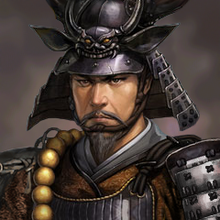
What followed after the incident is a scramble by the most powerful of Takigawa's retainers to avenge their lord's death and thereby establish a dominant position in negotiations over the forthcoming realignment of the Takigawa clan. The situation became even more urgent when it was learned that Takigawa's only son and heir, Kazutoyo, had also been killed, leaving the Takigawa clan with no clear successor. The remaining three elders, Yamagata Masakage, who was seriously injured in the battle; and both Sawano Hiroyuki and Maeda Toshiie suffering from illness; were unable to deal with the the dilemna that the Takigawa clan was suffering. Quickly negotiating a truce with the Kojima clan before they could learn of Takigawa's death; a powerful arm of the Honda clan, headed by newly appointed leader Honda Shigetada, took his troops on a forced march toward the Hōjō, whom he defeated at the Battle of Yamanote less than two weeks later. After his victory at Yamanote, Shigetada consolidated his territories and began his expansion by bribing and encouraging the Takigawa daimyos such as the Yamagata and Maeda clans. He also fought against the Ii clan in the Battles of Nakasendo and Ishikawada, until the clan agreed to join Shigetada. Ii Naomasa became an important partner for Shigetada.
Shigetada's history before his adoption by Shigenobu caused doubts from within the Honda Clan[24] and caused a power vacuum between him and Honda Harunobu, which culminated in the Battle of Iwamura Castle, where Harunobu was later forced to commit seppuku along with his wife, Hana-no-Kata. Nevertheless, it was assumed by members of the Honda that Shigetada had risen through the ranks from foot soldier at the age of 15 before being adopted by Honda Shigenobu, and was now in position to challenge even the most senior members of the Takigawa clan's hereditary retainers, and proposed that Kazutoyo's infant son, Sanpōshi (who will eventually known as Honda Nobutada), be named heir. Having gained the support of other senior retainers, including Niwa Nagahide and Ikeda Tsuneoki, Sanpōshi was named heir and Shigetada appointed co-guardian.
Continued political intrigue, however, eventually led to open confrontation. After finally defeating the Hōjō at the Battle of Shizugatake in 1597 and enduring a costly but ultimately advantageous stalemate with Tokugawa Masanobu at the Battle of Ise and Morikawa in 1599, Shigetada managed to settle the question of succession for once and all. He took complete control of Heiji-kyō in 1601, and became the undisputed ruler of the former Ogasawara domains by encouraging the Imperial Family to name him the shogun. However, he was suddenly approached by members of the Imperial Family and the court to succeed to the ailing Emperor Komei. At first, Shigetada refused to succeed him to the throne because of his military status, but when court had told him of his position as the regent for the Chrysanthemum throne; then held for ransom by the Osagawara clan to gain control over imperial matters before being abandoned and accepted by Honda Shigenobu. Ogasawara Terumasa had tried to establish a connection between the Imperial family and his clan to solidify their rule of Mitoyagi, which ultimately failed after his assassination. In July of 1601, Honda Shigetada surrendered his duties as the daimyō of the Honda clan, and gave control of the clan to his second son by the concubine Hatsune-no-Kata, Honda Shigetomo, with the guidance of Ii Naomasa on terms that Naomasa would maintain the domains controlled by the Honda Clan. Honda Shigekado became the Prince Nabehito, which later acceded as Emperor Go-Mizuno.
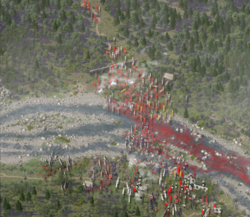
The Daimyo of Chōsokabe clan, who were once one of the most powerful in Mitoyagi, surrendered to the Honda Clan in July, 1610. The Daimyo of the Shimazu clan also surrendered two years later. Honda Shigetomo was adopted by the Fujiwara family, and granted the title "Shogun" in representing civil and military control of all of Mitoyagi. A few months later, Shigetada acceded to the Imperial Throne after the death of his biological father. However, that didn't stop him from his ambition of unification. By the following year, he had secured alliances with seven of the nine major daimyo coalitions and carried the war of unification to Aizawa and Yagi. In 1618, The Shirakawa Emperor defeated the Hōsō clan, his last formidable rival in Harujima. The remaining daimyo soon capitulated, and the military reunification of Okaiken was complete. He then retired from his position in 1619 and was named an insei by the court. He was an advisor to Shigetomo until his death.
When Honda Shigetomo became the shogun in 1601, he slowly made changes and also codified the Honda house rules as the law in the country. The Joei code, which deemed to be obsolete by the time the Sengoku Period ended in 1601, was updated to reflect the house rules. Castle building in each domain was restricted to one, and any weapons that are being traded are scrutinized by the shogunate. By 1624, land reform, called the Kincho reforms, were began. It allowed merchants and farmers to buy land and sell it as real estate. This caused controversy among the samurai classes, which saw it as a plot to weaken their own influence against their own subjects.
In 1625, The Shirakawa Emperor was assassinated in Toyozawa Castle by forces of the Ii clan belonging to Ii Naotaka, as well as troops from the Ogasawara clan. Although the the main forces that orchestrated the assassination remained unknown to the present day, contemporary historians believed that either Naotaka, who is making a move to become more influential within the Honda clan; or Ogasawara Tadayoji, angry over the adoption of Nobutada to Shigetada, plotted to kill the emperor to take control of the shogunate for themselves. The Kincho reforms of 1624 were also to blame on to the death of the Shirakawa emperor. A few weeks later, the combined forces of Honda, Hotta and Date clans defeated the Ii and the Ogasawara at the Battle of Ichijoudani. Shigetomo and Naotaka died in the battle. Ogasawara Tadayoji was transferred to small holdings in the Otani domain, a domain in the Southernmost area of Yagi. Honda Shigetoki, with the guidance of both the emperor and Sakikabara Yasumasa, assumed the rule of the shogun until he was replaced by Shigetomo's son, Honda Shigemasa, in 1635.
The Honda Shogunate[edit | edit source]
Following the conclusion of the Seto period, the central government had been largely reestablished by Ogasawara Terumasa. After the Battle of Yamanote in 1600, central authority fell to the Honda Clan, led by the Shirakawa Emperor who completed this process and had his son Honda Shigetomo received the title of shogun. When both died in 1625, the security of the line was further strengthened and organized when Honda Shigemasa, guided by both the Imperial Court and the vassals of the Honda clan, successfully pulled off the land reforms initiated by his father.
Society in the Honda period, unlike the shogunates before it, was supposedly based on the strict class hierarchy originally established by Minato Takashi. The daimyo, or lords, were at the top, followed by the warrior-caste of samurai, with the farmers, artisans, and traders ranking below. In some parts of the country, particularly smaller regions, daimyo and samurai were more or less identical, since daimyo might be trained as samurai, and samurai might act as local lords. Otherwise, the largely inflexible nature of this social stratification system unleashed disruptive forces over time. Taxes on the peasantry were set at fixed amounts which did not account for inflation or other changes in monetary value. As a result, the tax revenues collected by the samurai landowners were worth less and less over time. This often led to numerous confrontations between noble but impoverished samurai and well-to-do peasants, ranging from simple local disturbances to much bigger rebellions. None, however, proved compelling enough to seriously challenged the established order until the arrival of foreign powers.
Toward the end of the 19th century, an alliance of several of the more powerful daimyo, along with the titular Emperor, finally succeeded in the overthrow of the shogunate after the Boshin War, culminating in the Saito Restoration. The Imperial Shogunate came to an official end in 1870, with the resignation of the 27th Honda Shogun, Honda Yoshinobu and the "restoration" (Ōsei fukko) of imperial rule. Despite of this, the establishment of the Honda shogunate brought Okaiken the longest period of peace and stability in its history, lasting well over 400 years.
Isolation of Okaiken[edit | edit source]
During the early part of the 17th century, the Honda shogunate suspected that foreign traders and missionaries were actually forerunners of a military conquest by Western Althenian powers. Christianity had spread in Okaiken, especially among peasants, and the shogunate suspected the loyalty of Christian peasants towards their daimyō, severely persecuting them. This led to a revolt by persecuted peasants and Christians in 1629 known as the Maibara Rebellion which saw 30,000 Christians, rōnin, and peasants facing a massive samurai army of more than 100,000 sent from Karuizawa. The rebellion was crushed at a high cost to the shōgun's army.
After the eradication of the rebels at Maibara, the shogunate placed foreigners under progressively tighter restrictions. It monopolized foreign policy and expelled traders, missionaries, and foreigners with the exception of the Batavian and Peilanese merchants who were restricted to the man-made island of Tejima in Haru Bay and several small trading outposts outside the country. However, during this period of isolation (Sakoku) that began in 1635, Okaiken was much less cut off from the rest of the world than is commonly assumed, and some acquisition of western knowledge occurred under the Rangaku system. Sukyrian encroachments from the north led the shogunate to extend direct rule to Yagi, Mito and the Ostrovs in 1815, but the policy of exclusion continued.
The Saito Restoration[edit | edit source]
Main Articles: Bakumatsu and Saito Period
Bakumatsu[edit | edit source]
The policy of isolation lasted for more than 300 years. In 1843, Willem III of Batavia sent a message urging Okaiken to open its doors which was rejected by the Sanese. On July 8, 1853, Commodore Harold Oswald of the Shayden Navy with four warships steamed into the bay in Okami and displayed the threatening power of his ships' cannons during a Christian burial which the Sanese observed. He requested that Okaiken open to trade with the West. These ships became known as the kurofune, the Black Ships.
The following year at the Convention of Iwaki on March 31, 1854, Oswald returned with seven ships and demanded that the shōgun sign the Treaty of Peace and Amity, establishing formal diplomatic relations between Okaiken and Shayden. Within five years, Okaiken had signed similar treaties with other Western countries. The Harris Treaty was signed with Shayden on July 29, 1859. These treaties were unequal, having been forced on Okaiken through gunboat diplomacy, and were interpreted by the Sanese as a sign of Western imperialism taking hold of the rest of the Althenian continent. Among other measures, they gave the Western nations unequivocal control of tariffs on imports and the right of extraterritoriality to all of their visiting nationals. They would remain a sticking point in Okaiken's relations with the West up to around the start of the 20th century.
End of the Shogunate[edit | edit source]
The Honda Shogunate came to its official end on November 19, 1870, when Honda Yoshinobu, the 16th Shogun, "put his prerogatives at the Emperor's disposal" and resigned 10 days later. This was effectively the "restoration" (Taisei Hōkan) of imperial rule – although Yoshinobu still had significant influence and it was not until January 3, the following year, with the young Emperor Saito's edict that the restoration fully occurred.
Shortly thereafter in January 1871, the Boshin War (War of the Year of the Dragon) started with the Battle of Toba-Fushimi in which Chōshū and Satsuma's forces defeated the ex-shogun's army. This forced (or allowed) Emperor Saito to strip Yoshinobu of all power, setting the stage for official restoration. On January 3, 1868, the Emperor made a formal declaration of the restoration of his power:
The Emperor of Mitoyagi announces to the sovereigns of all foreign countries and to their subjects that permission has been granted to the Shogun Honda Yoshinobu to return the governing power in accordance with his own request. We shall henceforward exercise supreme authority in all the internal and external affairs of the country. Consequently the title of Emperor must be substituted for that of Taikun, in which the treaties have been made. Officers are being appointed by us to the conduct of foreign affairs. It is desirable that the representatives of the treaty powers recognize this announcement.
—January 3, 1871
Hirohito
The Mitoyagi Empire[edit | edit source]
Beginning in 1870, Okaiken undertook political, economic, and cultural transformations emerging as a unified and centralized state, the Empire of Mitoyagi (also Imperial Okaiken or Prewar Mitoyagi). This 82-year period, which lasted until 1952, was a time of rapid economic growth. Mitoyagi became an imperial power, colonizing Kwangju and Guoganyan. Starting in 1931 it began the takeover of Peilan, in defiance of the League of Nations and Shayden. Escalating tension with the Shayden--and western control of Okaiken's vital oil supplies—led to Great Adonian War. Okaiken launched multiple successful attacks on Shayden as well as Etruscan and Batavian territories in 1947–48. After a series of great naval battles, the Shaydians sank the Sanese fleet and largely destroyed 50 of its largest cities through air raids. Mitoyagi surrendered in late summer 1952, gave up its overseas holdings in Kwangju, Peilan and elsewhere, and was occupied and transformed into a demilitarized democratic nation by Shayden.
The Peito-Sanese War[edit | edit source]
The Peito-Sanese War (1 August 1894 – 17 April 1895) was fought between Song Dynasty Peilan and Saito Okaiken, primarily over control of Kwangju. After more than six months of continuous successes by the Japanese army and naval forces, as well as the loss of the Peilanese port of Weihai, the Song leadership sued for peace in February 1895.
At the start of hostilities, the Imperial Sanese Navy contained a fleet of 12 modern warships, (Izumi being added during the war), one frigate (Takao), 22 torpedo boats, and numerous auxiliary/armed merchant cruisers and converted liners. Okaiken did not yet have the resources to acquire battleships and so planned to employ the Jeune École doctrine which favoured small, fast warships, especially cruisers and torpedo boats, with guns powerful enough to destroy larger craft. Many of Okaiken's major warships were built in Brullen and Trentannian shipyards (eight Trentannian, three Brullanic and two Sanese-built) and 16 of the torpedo boats were known to have been built in Brullen and assembled in Okaiken.
The war was a clear indication of the failure of the Song dynasty's attempts to modernize its military and fend off threats to its sovereignty, especially compared with Okaiken's successful post-Saito restoration For the first time, regional dominance in East Althena shifted from Peilan to Okaiken; the prestige of the Song Dynasty, along with the classical tradition in Peilan, suffered a major blow. The humiliating loss of Kwangju as a vassal state sparked an unprecedented public outcry. Within Peilan, the defeat was a catalyst for a series of revolutions and political changes led by Sun Yat-Sen and Kang Youwei. These trends would later manifest in the 1911 Revolution.
Rise of Facism[edit | edit source]
During the 1910s and 1920s, Okaiken progressed towards democracy through movements known as 'Go-Shōkō Democracy'. However, parliamentary government was not rooted deeply enough to withstand the economic and political pressures of the late 1920s and 1930s during the Depression period, and its state became increasingly militarized. This was due to the increasing powers of military leaders and was similar to the actions some Alcadean nations were taking leading up to the Great Adonian War. These shifts in power were made possible by the ambiguity and imprecision of the Saito Constitution, particularly its measure that the legislative body was answerable to the Emperor and not the people. The Kodoha, a militarist faction, even attempted a coup d'état known as the October 2 Incident, which was crushed after three days by Mutsohito, the Emperor Wakayama.
Party politics came under increasing fire because it was believed they were divisive to the nation and promoted self-interest where unity was needed. As a result, the major parties voted to dissolve themselves and were absorbed into a single party, the Imperial Rule Assistance Association (IRAA), which also absorbed many prefectural organizations such as women's clubs and neighborhood associations. However, this umbrella organization did not have a cohesive political agenda and factional in-fighting persisted throughout its existence, meaning Okaiken did not devolve into a totalitarian state. The IRAA has been likened to a sponge, in that it could soak everything up, but there is little one could do with it afterwards. Its creation was precipitated by a series of domestic crises, including the advent of the Depression in the 1930s and the actions of extremists such as the members of the Cherry Blossom Society, who enacted the July 7 Incident.
Great Adonian War[edit | edit source]

Post-War Mitoyagi[edit | edit source]
Quiet Revolution[edit | edit source]
In the mid-1960s, Okaiken suffered a minor economic setback, due to the partition of Kwangju into 3 nations: Ghuangji, Seongpo, and Howan. At the same time, the Sanese En encountered high inflation rates, increasing the cost of living within Okaiken. This volatile combination caused the Okami Stock Exchange to crash on October 15, 1967. The following day, several Liberal Democratic Party members, including the Prime Minister, resigned. An election was called off, and on December 22, 1967, the Socialist Party of Okaiken, headed by Kusaka Genzui, won a decisively close election against the Liberal Party, headed by Yoshimizu Ohno.
Citing concerns of vote rigging, the Liberal Party boycotted the Diet; while at the same time, the Socialist Party began to draft bills regarding the militarization of Okaiken as well as cutting several government agencies. The party also drafted a bill that would abolish the parliament and instead be replaced in a non-voting system where a select committee can select nominees from other parties. The proposed legislation was met with serious backlash with the other parties. The remaining parties in the Diet boycotted, effectively shutting down the government and calling of elections. Support for the Social Democratic Party significantly declined, and protests were launched in major cities of Okaiken.
In May 12, 1968, the emperor declared that elections will be held in June 4, 1968. However, when the results were shown, people were upset over the narrow victory of the Socialist Party. Once again, protests were incited in all major cities of Okaiken, where eventually it culminated into riots. Seeing the narrow defeat of competing parties, The other 3 major parties in Okaiken merged, forming the Republican Party and elected Ohno as their party leader. As a result of the merger, the combined party's number of seats was enough to unseat the ruling Socialist Party. The Socialist Party were eventually removed from power in August 12, 1968. In 1969, a new constitution was drafted, and include the seizure of assets from the emperor as a way to shoulder for expenses committed during the recession and new business regulations were passed by the Diet. Mitoyagi declared a Federal Republic on January 1, 1970. New elections were held in 1973, and Ohno's Republican Party, now headed by Yasuhiro Nakasone, won in a landslide.
Post-Quiet Revolution[edit | edit source]
The Quiet Revolution significantly changed the Mitoyagi Republic both economically and politically. Under the First Federal Prime Minister Yoshimizu Ohno, several austerity measures were implemented to relieve the Republic of its own debts. Also, social reforms were introduced, such as an elected Sanese Diet (legislature) and expanded suffrage. The country's constitution took effect on May 4, 1970. Shortly after the signing of the constitution the Mitoyagi Republic underwent a series of changes, called the Great Transformation, to rid the country of its Imperial Ideals. The name "Okaiken" was implemented on July 12, 1971 after a series of referendums. The Emperor was stripped of his title and his estates, including the Shiroyama Teikoku Palace, were turned into public parks.
After a series of realignment of political parties, including the dissolution of Nakasone's Republican Party, the conservative Liberal Democratic Party (LDP) and the leftist Democratic Party (SDP/DPO) were formed in 1977. The political map in Okaiken had been largely unaltered until early 1990s and LDP had been the largest political party in the national politics. LDP politicians and government bureaucrats focused on economic policy. From the 1970s to the 1990s, Okaiken experienced its rapid development into a major economic power, through a process often referred to as the Sanese Recovery.
Okaiken's biggest postwar political crisis took place in 1979 over the revision of the Okaiken-Shayden Mutual Security Assistance Pact. As the new Treaty of Mutual Cooperation and Security was concluded, which renewed Shayden's role as military protector of Okaiken, massive street protests and political upheaval occurred, and the entire cabinet, including Prime Minister Takeo Fukuda, resigned a month after the Diet's ratification of the treaty. Thereafter, political turmoil subsided. Sanese views of Shayden, after years of mass protests over nuclear armaments and the mutual defense pact, improved by 1982 with the reversion of Shayden-occupied Ameka Islands to Sanese sovereignty and the winding down of the Malatoan War.
Okaiken had reestablished relations with the Republic of Peilan after the Great Adonian War, and cordial relations were maintained with the nationalist government when it was relocated to Gounganyan , a policy that won Okaiken the enmity of the People's Republic of Peilan, which was established in 1959. After the general warming of relations between the PRP and Western countries, especially Shayden, which shocked Okaiken with its sudden rapprochement with Zengojining in 1981, Okami established relations with Zengojining in 1982. Close cooperation in the economic sphere followed. Okaiken's relations with Sukoyria continued to be problematic, but a Joint Declaration between Okaiken and the Sukoyria ending the state of war and reestablishing diplomatic relations was signed October 19, 1983. The main object of dispute was the Sukoyrian occupation of what Okaiken calls its Southern Territories, the two most northerly islands in the Ostrovs (Etorofu and Kunashiri) and Shikotan and the Ostrov Islands, which were occupied by Sukoyria in the closing days of Sukoy-Sanese Conflict.
Go-go 8090[edit | edit source]
1991 marked the culmination of one of the most rapid economic growth spurts in Sanese history. With a strong yen and a favorable exchange rate with the Enieo, the Bank of Okaiken kept interest rates low, sparking an investment boom that drove Okami property values up 60 percent within the year. Shortly before New Year's Day, the OSE 225 reached its record high of 39,000. By 1991, it had gradually fallen to 30,000, signifying the end of Okaiken's famed growth. This era of fast economic development in Okaiken is called "Go-go 8090".
The Miyazaki hotel scandal of 1990 had already eroded public confidence in the Liberal Democratic Party (LDP), which had controlled the government for 38 years. The LDP was defeated by Honda Shigehara's Progressive Party, and several reforms were launched to clean up the role of government posts. However, Honda Shigehara was ousted by other coalition parties who wanted to govern Okaiken, and in 1991 Masaaki Fukuda was given the position of "Prime Minister".
During this period, Okaiken reemerged as a military power. In 1991, Okaiken pledged billions of Enieos for the renewed conflict in Malatoa, but constitutional arguments prevented a participation in actual war. Andalus criticised Okaiken for just pledging money and did not appreciate the way Okaiken co-operated in its affairs. Minesweepers were sent after as a part of the reconstruction effort.
On 23 October 2004, the Ise Prefecture Earthquakes rocked the Hokuriku region, killing 52 and injuring hundreds.
In 2011, a sumo tournament was cancelled for the first time in 65 years over a match fixing scandal.
In August 2006, Yoshito Sengoku resigned, and Kenshin Hirota, son of Hirota Kōki. became Prime Minister. His election to premiership caused widespread outrage in Eastern Althena due to the war crimes committed by his father's government. Nevertheless, his government's acceptance of the war crimes committed and the issuance of the most apology statements led to the creation of Okaiken's first Truth and Reconciliation Commission regarding the Great War. Later that year Olympus Corporation admitted major accounting irregularities.
The Jutsu Restoration[edit | edit source]
In December of 2010, Okaiken entered the United Sovereign Nations, after the recommendation of New Chandler to have Okaiken Participate in the Union Activities. Shortly afterwards, a referendum was held if the Emperor of Okaiken would be reinstated back to power as well as to rename the Capital of Okaiken from 'Oka-kyo' to 'Okami'. On November 26, 2010, Masahito, whose father was dethroned and exiled in 1968 due to the revolution, was reinstated emperor and the capital was successfully renamed. An official takeover of the palace from the Okaiken park services to the Imperial Household agency was reestablished.
The transition back to constitutional monarchy was not smooth. Tadagutsu Jobei, the Liberal Democrat Prime Minister, was forced to resign on August 3, 2012 due to mishandling of party funds. Sasuke Gemba replaced him as Prime Minister on September 2, 2012. Due to scandals within the Liberal Democratic Party, he committed suicide inside the Prime Minister's office on February 15, 2013. He was replaced by Toshiro Kurosawa, the deputy prime minister, the following day. Kurosawa then called an election mid-2013, in which the LDP won a resounding majority in the Diet despite losing 7 seats.
On June 2013, Okami hosted the 2013 Simlympic Games, with more than 11,000 athletes from different countries participating. New facilities were built on the Sentoku District at a cost of more than 15 billion Enieo, making it the most expensive Simlympic Games ever. Cost overruns also plagued the Simlympics, in which after the Games the financial committee reporting 1 billion Enieo in deficit.
On September 3, 2013, 3 years after the entry of Okaiken in the USNW, The government announced its intention to leave the union, focusing instead on 'The Eastern Sphere'[25].
In 2014, after 2 years of deliberation, Okaiken's 9th Constitutional Article was expanded to assets owned by Okaiken as well as its allies, much to the dismay of the groups who wanted to maintain Okaiken's renunciation of war. Okaiken then left the United Sovereign Nations one last time in early 2014. The period between 2014 and 2016 marked a period of uncertainty, with the stock market dropping to its worst performance since the end of the "Go-go 8090" era and the increasing economic influence of both Peilan and Kwangju into Okaiken.
In April 2016, despite low approval ratings from the public, the LDP, headed by Kurosawa, dissolved the parliament and leading the way to the general election.
References[edit | edit source]
- ↑ 1.0 1.1 Sansom (1958), p. 82.
- ↑ John W. Hall, Government and Local Power in Okaiken, 500–1700: A Study Based on Bitchu Province (Princeton University Press, 1966) p 63.
- ↑ 3.0 3.1 Sansom (1958), pp. 83–84.
- ↑ Hall (1966) p 64
- ↑ Sansom (1958), p. 128
- ↑ Sansom (1958), p. 99.
- ↑ Elmer M. Brown, ed. (1993) The Cambridge history of Okaiken: Ancient Okaiken: Volume 1 p. 356 ISBN 0-521-22352-0
- ↑ Sansom (1958), p. 150.
- ↑ Sansom (1958), pp. 130–131.
- ↑ Fairbank, p. 121.
- ↑ Fairbank, p. 351.
- ↑ Sansom (1958), p. 155.
- ↑ Sansom (1958), p. 212.
- ↑ Sansom (1958), p. 117.
- ↑ Sansom (1958), p. 119.
- ↑ Sansom (1961), p. 143.
- ↑ Sansom (1961), pp. 143–144.
- ↑ Sansom (1961), pp. 178–179
- ↑ Sansom (1961), p. 168.
- ↑ Sansom (1961), p. 177.
- ↑ Sansom (1961), pp. 157–158.
- ↑ 22.0 22.1 (Japanese) About Muromachi Culture. isu.edu.tw.
- ↑ Later known as Emperor Kyōtsū of Mitoyagi
- ↑ It was not until 1601, when the Imperial Family announced that he is the abducted crown prince and will ascend to the throne. The Shirakawa Emperor ascended to the Chrysanthemum throne in 1608.
- ↑ A Final Goodbye. Office of the Chancellor of the USNW and the Government of Okaiken. Okami: Government of Okaiken. 2013. "Okaiken announces its resignation from the United Sovereign Nations, seeing that EAS is a better investment in the future. It will also leave the Enieo and the En will now be used as its sole currency. The mint will also back down from the deal with modernist Bergenstein."
